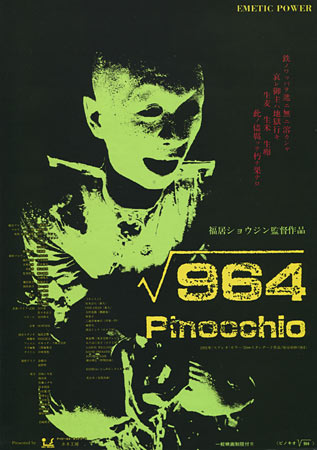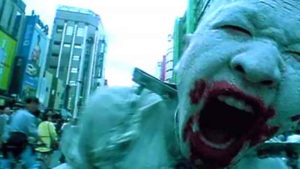 Hong Kong films have in recent years become popular with American cineastes for their over-the-top qualities; however, true Asian cinema buffs know that the wildest fare comes not from Hong Kong, but from Japan. Case in point, PINOCCHIO 964 (1991), a prime example of cyberpunk cinema. Others include TETSUO (1990) and DEATH POWDER (1986), but PINOCCHIO 964 is by far the wildest film this sub-genre has to offer. Director Shozin Fukui employs several over-the-top touches, creating what may be the ultimate “punk” movie.
Hong Kong films have in recent years become popular with American cineastes for their over-the-top qualities; however, true Asian cinema buffs know that the wildest fare comes not from Hong Kong, but from Japan. Case in point, PINOCCHIO 964 (1991), a prime example of cyberpunk cinema. Others include TETSUO (1990) and DEATH POWDER (1986), but PINOCCHIO 964 is by far the wildest film this sub-genre has to offer. Director Shozin Fukui employs several over-the-top touches, creating what may be the ultimate “punk” movie.
PINOCCHIO 964 is by far the wildest film this sub-genre has to offer.
This was the first feature by writer/director Shozin Fukiui, following the well received shorts “Gerorisuto” (1987) and “Caterpillar” (1988). A brief scene over the end credits featuring the cast wigging-out with a punk band shows PINOCCHIO 964’s true loyalties. Its demented subject matter, loud industrial soundtrack, confrontational sex and gore scenes, and performances that teeter precariously on the edge of hysteria make PINOCCHIO 964 ideal viewing for the spike-haired, pierced-lips set. It‘s almost certainly be one the most outrageous films ever to come out of Japan, and perfect for anyone interested in the extremes of underground filmmaking.
…ideal viewing for the spike-haired, pierced-lips set
Pinocchio, a cyborg built to sexually satisfy lonely women, is thrown out onto the street by its dissatisfied owners, a depraved lesbian couple. After taking up with a young homeless woman, the rapidly malfunctioning android attempts to confront its creators.
Clearly, plot wasn’t the main thing on writer-director Shozin Fukui’s mind. It’s the grotesque and disturbing imagery that takes center stage—excessive gore, drool, slime and what may be the most prolonged vomiting scene ever. Definitely not for all tastes, PINOCCHIO 964 is strictly a love-it-or-hate-it experience.
 Shozin Fukui is either a cinematic genius or a complete lunatic. Either way, the film is a total mindblower. The many stylistic eccentricities on display here include use of extremely wide lenses, angles shot from a vertical perspective, shots held for an unconscionably long time, fast motion, etc. It’s often difficult to know if we’re meant to take the proceedings seriously, particularly during Pinocchio’s climactic rampage through the streets of Tokyo and his subsequent showdown with his insane creators. (This confrontation includes epilepsy, heart and face ripping, transplanted heads, and a declaration of true love—did I not say this was weird?) Fukui’s current status in the Japanese film industry is unknown to me but then, do I really want to find out?
Shozin Fukui is either a cinematic genius or a complete lunatic. Either way, the film is a total mindblower. The many stylistic eccentricities on display here include use of extremely wide lenses, angles shot from a vertical perspective, shots held for an unconscionably long time, fast motion, etc. It’s often difficult to know if we’re meant to take the proceedings seriously, particularly during Pinocchio’s climactic rampage through the streets of Tokyo and his subsequent showdown with his insane creators. (This confrontation includes epilepsy, heart and face ripping, transplanted heads, and a declaration of true love—did I not say this was weird?) Fukui’s current status in the Japanese film industry is unknown to me but then, do I really want to find out?
Definitely not for all tastes, PINOCCHIO 964 is strictly a love-it-or-hate-it experience.
(Postscript: Fukui went on to make the black-and-white cyber-horror fest RUBBER’S LOVER in 1996; both films are currently available on DVD in the U.S. from Unearthed Films.)
Vital Statistics
PINOCCHIO 964 (a.k.a. SCREAMS OF BLASPHEMY)
Anthem Pictures
Director: Shozin Fukui
Screenplay: Shozin Fukui
Cast: Hage Suzuki, Onn-Chan, Kyouko Hara, Ranyaku Mikutei
